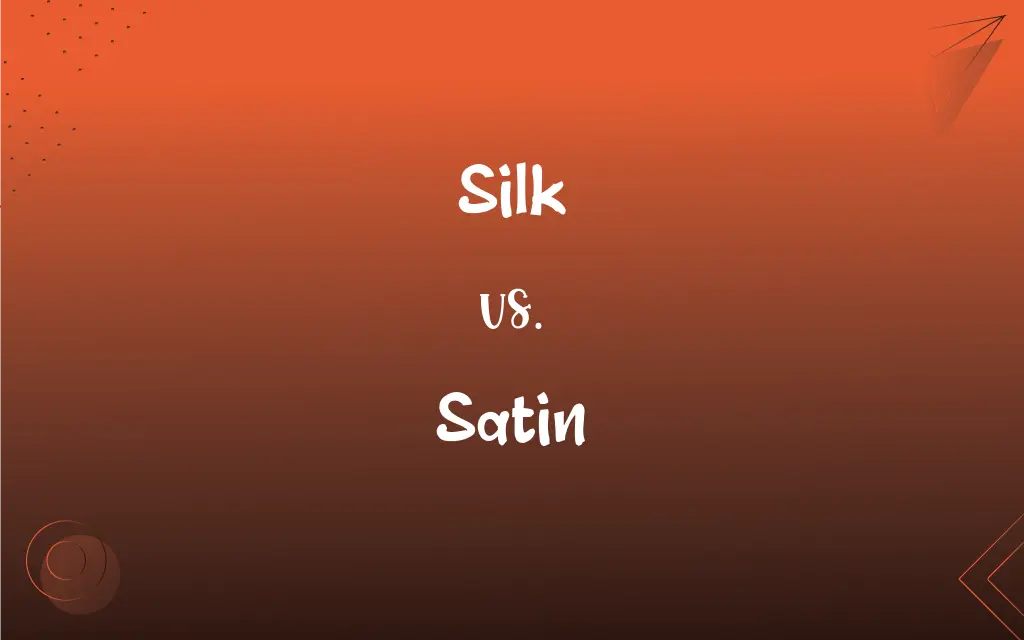Silk vs. Satin: What's the Difference?
Edited by Aimie Carlson || By Harlon Moss || Updated on October 13, 2023
Silk is a natural protein fiber obtained from silkworms, while satin is a weave pattern giving fabric a glossy surface.

Key Differences
Silk is renowned as a luxurious material that originates from the cocoons of silkworms. Satin, on the other hand, isn't a fiber like silk but a specific weave pattern.
The beauty of silk lies in its natural origin, creating a smooth and shimmering appearance. Satin's shine, conversely, comes primarily from the way the threads are woven together.
Fabrics, when woven in the satin method, present a shiny surface because of the floated (or missed) weft threads. Silk, irrespective of weave, carries an inherent sheen due to its natural properties.
Silk fabrics can sometimes be woven in the satin pattern, thereby enhancing their natural luster. Satin, however, can be made from various materials, including polyester, acetate, and yes, silk itself.
Durability and care can vary for both; silk is delicate and requires gentle handling, whereas satin's durability is influenced by the type of fibers used in the weave.
ADVERTISEMENT
Comparison Chart
Source
Natural protein fiber from silkworm cocoons.
Weave pattern, not a natural source.
Texture
Naturally smooth and shiny.
Smooth and glossy due to weave pattern.
Common Use
Apparel, accessories, bedding.
Dresses, bedding, upholstery, accessories.
Composition
Natural fibers.
Can be made from various fibers including silk itself.
Care and Durability
Delicate and may require hand-washing.
Varies based on the fiber used in its weave.
ADVERTISEMENT
Silk and Satin Definitions
Silk
Silk is a fine, strong, soft lustrous fiber produced by silkworms.
The dress, made of pure silk, shimmered under the spotlight.
Satin
Satin can be created using various fibers, including silk, nylon, or polyester.
The dress was made of polyester satin, offering a glossy look at a lower cost.
Silk
Originating in ancient China, silk has long been a symbol of luxury.
Traders once transported silk across vast distances on the Silk Road.
Satin
The weave of satin utilizes four or more fill or weft yarns floating over a warp yarn.
The meticulous weave technique gives satin its characteristic shine and smoothness.
Silk
Silk serves as the building material for cocoons in the insect world.
The silkworm spins its cocoon using liquid silk.
Satin
Satin is often used in apparel, upholstery, bed sheets, and drapery due to its luxurious feel.
The satin dress flowed gracefully as she moved across the room.
Silk
Silk's smooth texture makes it a popular choice for premium garments.
Nothing compares to the comfort of a silk scarf on a chilly evening.
Satin
Satin is a fabric weave that typically has a glossy surface and a dull back.
The satin sheets provided a smooth and cool sleeping surface.
Silk
Silk's inherent sheen comes from its prism-like structure.
The silk curtain cast a soft, reflective glow in the room.
Satin
Although satin can be made from silk, it isn’t inherently a type of silk but a weave.
Despite being made of silk, the fabric wasn't satin due to its different weave style.
Silk
A fine lustrous fiber composed mainly of fibroin and produced by certain insect larvae to form cocoons, especially the strong, elastic, fibrous secretion of silkworms used to make thread and fabric.
Satin
A smooth, often silk fabric that is woven with a glossy face and a dull back.
Silk
Thread or fabric made from this fiber.
Satin
A garment made of this fabric.
FAQs
Is satin a type of silk?
No, satin is a weave, not a fiber, and can be made from various materials, including silk.
Does silk originate from China?
Yes, silk was first developed in ancient China.
Is silk a natural or synthetic fiber?
Silk is a natural fiber produced by silkworms.
How should silk be cared for?
Silk often requires gentle care, such as hand-washing or dry-cleaning.
Are silk garments typically lightweight?
Yes, silk garments are often lightweight and offer a soft drape.
Is satin typically smooth to touch?
Yes, satin is known for its smooth and glossy surface.
Are satin sheets typically slippery?
Yes, satin sheets tend to be smooth and may feel slippery.
Can silk be woven into satin?
Yes, silk can be woven in the satin weave style.
Why is silk considered luxurious?
Silk is considered luxurious due to its smooth texture and natural luster.
Can satin be made from synthetic fibers?
Yes, satin can be made from various fibers, including synthetic ones like polyester.
What kinds of items are often made with satin?
Items like bedding, clothing, and upholstery are often made with satin.
Are satin and sateen the same?
No, while both have a glossy surface, satin and sateen have different weave patterns and typically use different fibers.
What is silk made from?
Silk is made from the fibers produced by silkworms.
What gives satin its glossy appearance?
The glossy appearance of satin comes from its specific weave pattern.
What is the significance of the Silk Road?
The Silk Road was an ancient network of trade routes connecting the East and West, notable for the silk traded along it.
Why is silk often more expensive than other fabrics?
Silk is often more expensive due to its complex production process and natural origin.
Can satin be used for wedding dresses?
Yes, satin is a popular choice for wedding dresses due to its luxurious sheen.
Is satin resistant to wrinkles?
Satin is generally less prone to wrinkles compared to many other fabrics.
Does satin shine on both sides?
Typically, satin has a glossy surface on one side and a dull finish on the other.
Does silk provide thermal insulation?
Yes, silk can act as a natural thermal insulator, keeping you warm in winter and cool in summer.
About Author
Written by
Harlon MossHarlon is a seasoned quality moderator and accomplished content writer for Difference Wiki. An alumnus of the prestigious University of California, he earned his degree in Computer Science. Leveraging his academic background, Harlon brings a meticulous and informed perspective to his work, ensuring content accuracy and excellence.
Edited by
Aimie CarlsonAimie Carlson, holding a master's degree in English literature, is a fervent English language enthusiast. She lends her writing talents to Difference Wiki, a prominent website that specializes in comparisons, offering readers insightful analyses that both captivate and inform.































































